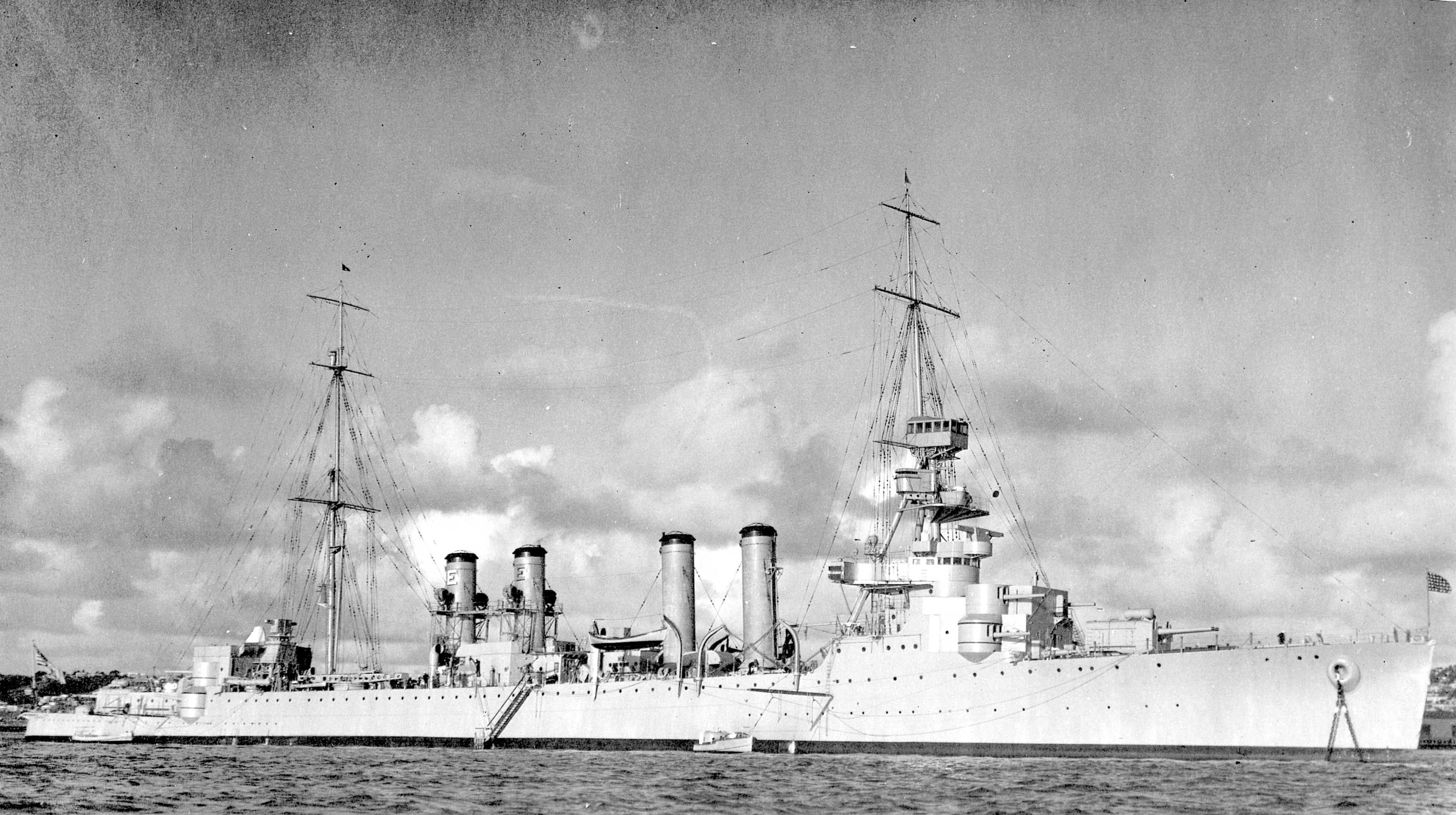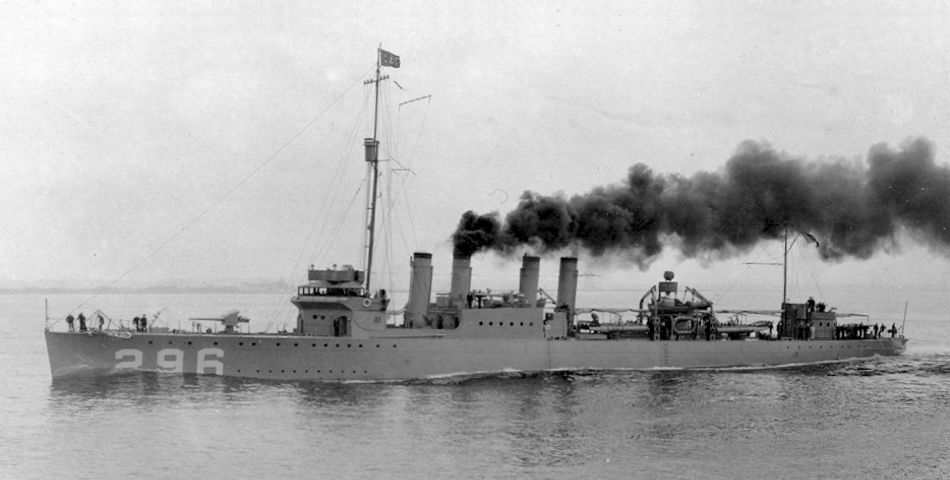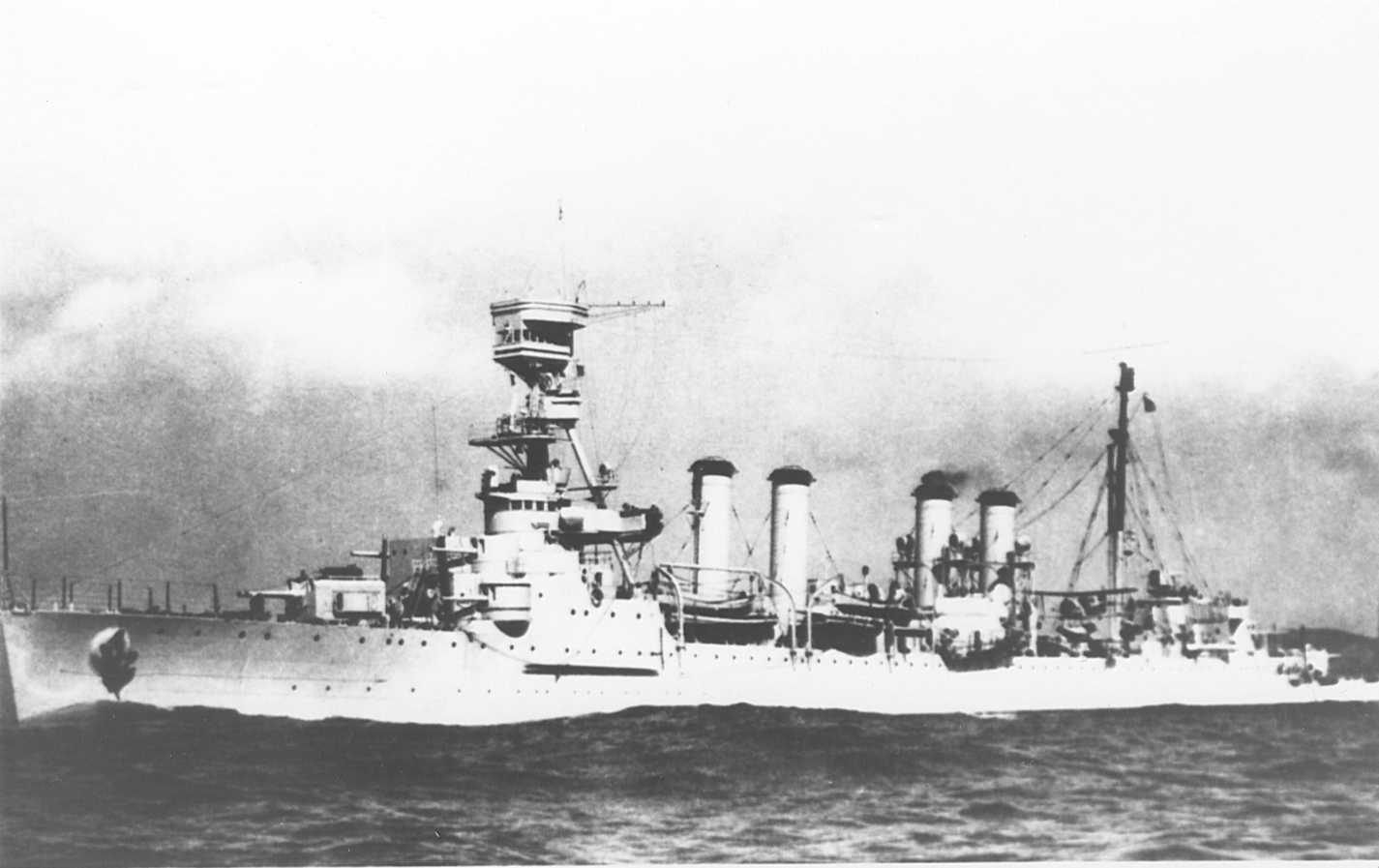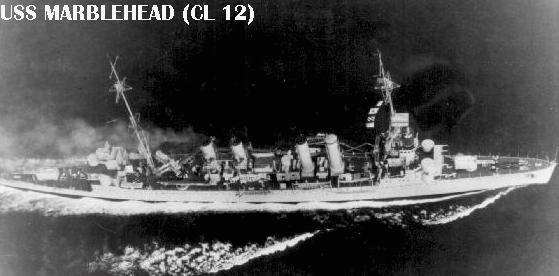Following on from last weeks post, the Phoenix was the pre-cursor design that originally went into the plan and development work for the Omaha class cruiser. The Omaha's design and development was as a direct result of the introduction of the British Centaur C Class Cruisers. The American Navy felt that they had nothing that could for fill the role of light scout cruiser like this new British Cruiser and wanted a ship that could push up with other destroyers to give support to them and relay enemy position information to a larger fleet.
The Omaha Class Cruiser
When the Omaha was in its design phase it was specifically made to look like the Clemson class destroyers currently in use by the US. The Omaha was given four smoke stacks in a arrangement like the Clemson and was even painted in the same camouflage scheme to further increase the resemblance.
Clemson class destroyer
The Omaha also shows the movement away from casemate mounted gun design to the fully turreted guns design philosophy after the first world war. The Omaha was launched in the 1920's and has a displacement of 7100 long tons or just shy of 7214 metric tons. Design changes during mid production meant that on the Omaha's launch it was a badly overloaded design. Sacrifices in weight to maintain the ships initial speed specification lead to the ship compromising on crew habitability. The ship was poorly insulated meaning it was too hot in the tropic theatre of operations and too cold in the freezing climates. On top of this the overburdened design frequently lead to the ship taking on water over the bow and through the Torpedo compartments located at the aft of the ship. A serious flaw was the lack of water tight bulkheads anywhere above the main deck or aft on the main deck. The Hull had a nasty habit of leaking due to its light build, this lead to sustained high speed steaming contaminating the oil tanks with sea water. Sea water in the oil Boilers was a big risk as this could cause the boilers to explode if not properly tended.
Originally designed to serve as a scout the Omaha class cruisers served throughout the inter war periods as the lead ship in fleet flotillas (or small ship formations such as destroyers). With the introduction of air scouts and scouting roles being taken over by heavy cruisers (due to the Washington Treaty) the Omaha never really fulfilled its design function. The Omaha cruisers were relegated to fleet screening where its high fire-power output and speed were needed.
Entering into the second world war the Omaha was the oldest serving Cruiser that was still in service in the US Navy and was mostly assigned secondary and patrol roles where the least danger was. Naturally this meant that the ships didn't have a hugely exciting service history. 2 Omaha ships were present in Pearl Harbour, the Detroit and Raleigh Omaha class Cruisers. The Raleigh was torpedoed during the attack at Pearl Harbour but not sunk. The Marblehead and the Richmond Omaha class cruiser had the most interesting history. The Marblehead in the battle of the Makassar Strait received 2 bomb hits that penetrated the decks and killed 15 crew and 1 near miss that caused a hole underneath the waterline and jammed the rudder. The marblehead survived the attack and was able to get temporary repairs before heading back to the east coast of the US.
The Richmonds engagement in the Battle of Komandorski Islands was one of the more unusual engagements of the second world war. The fleet which the Richmond was in was on its way to intercept a Japanese supply convoy on their way to the Aleutian Islands. The Japanese convoy consisted of more ships than the original intelligence lead them to believe. When the 2 fleets met it was in open ocean and neither fleet had air or submarine support. The ensuing battle was one of the last purely naval gunnery duel in naval history. The battle was inconclusive with both sides receiving heavy damage, the Japanese Admiral rather than capitalising on his number superiority and the heavy damage done to the US attackers retreated leaving the Battlefield fearing a probable air attack from the US in support of their fleet .
The Richmond Omaha class cruiser managed to badly damage the Nachi Heavy Cruiser during this battle knocking out her electrics to the ammo hoists and gun mounts with 2 hits from her 6 inch guns whilst dodging gun fire and torpedoes in return.
In World of warships the Omaha is a good cruiser. Her armament is better than the preceding Phoenix Class Cruiser and with playing through the previous tier you should be well aware of its strengths and weaknesses. Like the Phoenix the armour for a light cruiser sucks but the Omaha has a lot of guns with a decent fire rate mixed with decent speed, making you a very potent threat for other destroyers and cruisers. With a full broadside she can fire 8 guns and each gun can spit 8.6 rounds per minute. Compared with the Phoenix, Kuma and Furutaka she outclasses all her competitors on the amount of guns and DPM she can dish out. At tier 5 the Japanese cruisers get their 205mm guns but bigger is definitely not better in this instance. The rate of fire of the Omaha outclasses the Furutaka's to such a extent you should be able to win one on one fight every time.
Approaching the enemy showing as little a target as possible whilst maintaining the largest amount of guns on target
The Omaha is also very manoeuvrable having the smallest turning circle of any cruiser in a 1 tier spread (in both the american and jap tech trees). Its rudder shift speed is very good also at 7.5 seconds. The Furutaka has a 1.6 second disadvantage at 8.6 seconds whilst the Aoba has a 11 second rudder shift time. This makes the Omaha very responsive which is good for avoiding gun fire and torpedoes. With the light armour of your cruiser this will be your main defence because not taking fire is how you will survive. Due to the bad armour of the Omaha is suffers for a smaller heath pool than the Japanese Furutaka but this isn't really a ship that you should be having a lone wolf mentality in at the start. You should be choosing when to use your health to trade for a kill or strategic point capture
The Turret Rotation Speed from the Pheonix to the Omaha takes a substantial drop from 18 seconds to 24 seconds. The gun arrangement on the ship means that you will always have some guns to fire on enemies that are flanking you but you will notice this the most when you are trying to turn your turreted guns all the way around when dodging in coming fire. This requires better battlefield awareness than the Phoenix to make the most of your gun advantage in the middle of a fight. Being able to respond to threats before they happen will help you dish out the damage and get kills in this ship so pay attention to your mini map as much as possible for your team and enemies positions.
The main problem that you are going to face in the Omaha is that its no where near a match to any of the ships one tier higher than it. The Cleveland has 9 amazingly fast firing turreted guns which have a good range. The Omaha's armour just can't compete with the Cleveland overwhelming fire power. The Aoba houses 6 205mm guns that have a reasonable fire rate and long range. The Aoba's Torpedoes are deadly with a damage potential of 16.2k combined with a 10 km range. The Guns on the Omaha would let you put up a fight but the light armour of the cruiser is again the Omaha's biggest weakness. A few lucky/well aimed shots from a Aoba can ruin your day when captaining a Omaha as the Aoba's shells hurt. Between Tiers 5 and 6 their is no bigger jump in ship performance anywhere else on the tech tree than here in the cruisers line. (This reiterates my point from a previous post that their should be another ship here that replaces the Phoenix/Omaha so this jump is not so harsh in the American cruiser line)
Proof that the Omaha can be good when used effectively
This however does not mean this is a bad ship, in fact this ship is great when you use it well. This ship is a improvement on the Phoenix in almost every way. More guns more AA more health just makes this American better. Remembering your armour is bad and positioning yourself to avoid incoming fire is the key to survival in this ship. Bad positioning against Japanese cruisers higher calibre guns generally ends in citadel hits. Angle your armour to make the best of it or alternatively wolf pack and give them something else to shoot at. The same principles of the Phoenix apply but this time you have more fire power, keep those guns singing whilst supporting other cruisers and destroyers. If your out in front and feel your in a bad position its not a bad thing in this ship to fall back. The Omaha can't take sustained fire so use the ship accordingly Use your fire rate to get consistently good games with high damage output . Remember this is the last US non premium Cruiser that gets torpedoes so use them whilst you've got them as a trump card.








No comments:
Post a Comment